|
Cover
Story
The
Pictures of
Resistance
Mustafa
Zaman
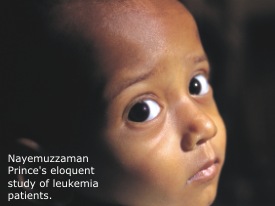 Resistance
denotes a whole range of meanings. In Iraq we are witnessing
its patriotic colour that is often soaked in blood. On the
home front, Drik picture Library Ltd, the institution for
promoting documentary photography, is all set to overwhelm
us with the artistic manifestations of the same. To quote
the words of Shahidul Alam, the man who established Drik and
who remains its driving force, "Resistance has been there
in different forms and against various established norms --
political organisations, religious zeal, media propaganda
and commercialism to name a few." "And throughout
this resistance, pioneer photographers have continued their
struggles amidst adversities to create an identity for professional
photography in Bangladesh," continues Alam. His reference
is to the struggle that led to independent Bangladesh and
to the people's resistance to oppressive regimes. Chobi Mela
III is the third effort by Drik. To lend the biannual event
a broader significance it strives to showcase internationally
reputed photographers from the world around. It has been designed
to encapsulate the spirit of resistance in its myriad forms
in a show that will be dispersed in numerous venues in Dhaka. Resistance
denotes a whole range of meanings. In Iraq we are witnessing
its patriotic colour that is often soaked in blood. On the
home front, Drik picture Library Ltd, the institution for
promoting documentary photography, is all set to overwhelm
us with the artistic manifestations of the same. To quote
the words of Shahidul Alam, the man who established Drik and
who remains its driving force, "Resistance has been there
in different forms and against various established norms --
political organisations, religious zeal, media propaganda
and commercialism to name a few." "And throughout
this resistance, pioneer photographers have continued their
struggles amidst adversities to create an identity for professional
photography in Bangladesh," continues Alam. His reference
is to the struggle that led to independent Bangladesh and
to the people's resistance to oppressive regimes. Chobi Mela
III is the third effort by Drik. To lend the biannual event
a broader significance it strives to showcase internationally
reputed photographers from the world around. It has been designed
to encapsulate the spirit of resistance in its myriad forms
in a show that will be dispersed in numerous venues in Dhaka.
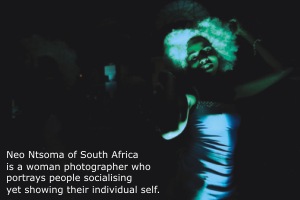 The
Chobi Mela III, which has been keeping Alam and his contingent
at their busiest, is an international event that was "created
to raise awareness of the present state of photography in
the region and deconstruct current photographic practices."
The last two Chobi Melas tried the same. According to Shahidul
Alam, "Every one of the themes of the three Chobi Melas
reflects the existing time and political atmosphere." The
Chobi Mela III, which has been keeping Alam and his contingent
at their busiest, is an international event that was "created
to raise awareness of the present state of photography in
the region and deconstruct current photographic practices."
The last two Chobi Melas tried the same. According to Shahidul
Alam, "Every one of the themes of the three Chobi Melas
reflects the existing time and political atmosphere."
The first one, held in 2000, had the theme
of "Difference". There was also a special segment
attached to the festival, which brought into light many unpublished
photographs of the 1971 Liberation War of Bangladesh. The
segment was aptly titled, "The War We Forgot".
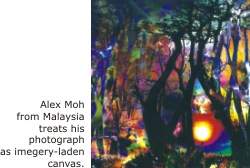 The
second Chhobi Mela based itself on the theme of "Exclusion:You
are either with us, or against us". As the festival director,
Alam shares all the heat that we associate with the theme
of the third Chobi Mela. He articulates, "Each pen that
fails to write, each shutter that fails to open, each voice
that refuses to shout in protest when governmental and corporate
power flex its muscle, bears the guilt of compliance. This
festival in giving space to the excluded, pays homage to the
few who continued to say no." The
second Chhobi Mela based itself on the theme of "Exclusion:You
are either with us, or against us". As the festival director,
Alam shares all the heat that we associate with the theme
of the third Chobi Mela. He articulates, "Each pen that
fails to write, each shutter that fails to open, each voice
that refuses to shout in protest when governmental and corporate
power flex its muscle, bears the guilt of compliance. This
festival in giving space to the excluded, pays homage to the
few who continued to say no."
<>Saying "no" to exploitation
through photography. What spurs one to think of such a passive
form of resistence? Alam has an unambiguous answer. He states
the need for implementation of "mass visual literacy"
that can have a bearing in the real issues. On top of that
he invites the photographers to "resist the political
and social stigma connected with their careers, as photographers
are major reformers".
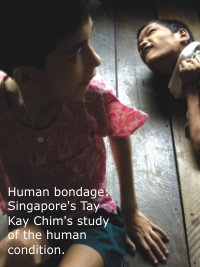 In
the Chobi Mela III photographs from all the continents except
Australia are to be exhibited. There will be a section that
will present the development in the photographic landscape
in Bangladesh. A segment of the main exhibition from Bangladesh
will comprise the work of three Bangladeshi photographers.
They are Abir Abdullah, Naymuzzaman Prince and Shahidul Alam. In
the Chobi Mela III photographs from all the continents except
Australia are to be exhibited. There will be a section that
will present the development in the photographic landscape
in Bangladesh. A segment of the main exhibition from Bangladesh
will comprise the work of three Bangladeshi photographers.
They are Abir Abdullah, Naymuzzaman Prince and Shahidul Alam.
Abir
Abdullah's engagement with Shakharibazar grew out of his first
attempt to document the people and life in this area. It was
during his course with Pathshala, the training cell of Drik,
that Abdullah had begun his love affair with Shakharibazar.
He didn't know that he was to record the recent collapse of
a hundred years old building in the area that cost several
lives. "I have been photographing Shakharibazar since
1999 as a three-year project titled 'Hindu Religious Festival'
assigned by the World Press Photo Foundation as well as part
of my course work with Pathshala," explains Abdullah.
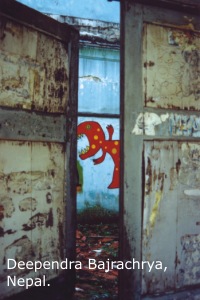 During
this time he developed a relationship through his camera with
the people living in the area of Old Dhaka. The set of 12
photographs that will represent Abdullah in Chobi Mela III
reveals his engagement with the people of Old Dhaka. He captures
a Shakharibazar at its most vulnerable. The batch of photographs
titled "We are born here and will die here" brings
into view the Shakharibazar tragedy and reveals the people's
struggle to get a grip of their loss frame by frame. "My
work is all about the lives of these people. Just as I have
captured a son in the tight clasp of his father's arms, both
dead while remained imprisoned under the rubble for hours,
I have also recorded a newborn being greeted by the family
according to the tradition of the area," reveals Abdullah
whose interest lies in the study of human integrity. He is
fascinated by the resolve of the people of Shakharibazar,
whose motto, as Abdullah had found out, is, "We are born
here and will die here". "As the people of this
area belongs to the religious minority, they are determined
to live together even in the worst of situations," Abdullah
let us know. Than he hastens to add, "…to them
resistance has a different meaning every morning." During
this time he developed a relationship through his camera with
the people living in the area of Old Dhaka. The set of 12
photographs that will represent Abdullah in Chobi Mela III
reveals his engagement with the people of Old Dhaka. He captures
a Shakharibazar at its most vulnerable. The batch of photographs
titled "We are born here and will die here" brings
into view the Shakharibazar tragedy and reveals the people's
struggle to get a grip of their loss frame by frame. "My
work is all about the lives of these people. Just as I have
captured a son in the tight clasp of his father's arms, both
dead while remained imprisoned under the rubble for hours,
I have also recorded a newborn being greeted by the family
according to the tradition of the area," reveals Abdullah
whose interest lies in the study of human integrity. He is
fascinated by the resolve of the people of Shakharibazar,
whose motto, as Abdullah had found out, is, "We are born
here and will die here". "As the people of this
area belongs to the religious minority, they are determined
to live together even in the worst of situations," Abdullah
let us know. Than he hastens to add, "…to them
resistance has a different meaning every morning."
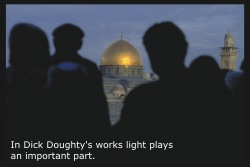 Naymuzzaman
Prince too specialises in social issues. But he seeks out
the patches that mostly remains in the dark, removed from
our everyday reading of reality. The outcome of his three
year journey that maps a least-known territory may incite
unbound pathos. He has been recording the children with leukemia.
"Unlike adults, children are not preoccupied with the
malady they are afflicted with. Even if it is a terminal disease
they would rather enjoy their present than be tormented by
what tomorrow has in store," says Prince. "How long
and going to live? Such questions don't bother them, this
has affected me beyond imagination," Prince exclaims. Naymuzzaman
Prince too specialises in social issues. But he seeks out
the patches that mostly remains in the dark, removed from
our everyday reading of reality. The outcome of his three
year journey that maps a least-known territory may incite
unbound pathos. He has been recording the children with leukemia.
"Unlike adults, children are not preoccupied with the
malady they are afflicted with. Even if it is a terminal disease
they would rather enjoy their present than be tormented by
what tomorrow has in store," says Prince. "How long
and going to live? Such questions don't bother them, this
has affected me beyond imagination," Prince exclaims.
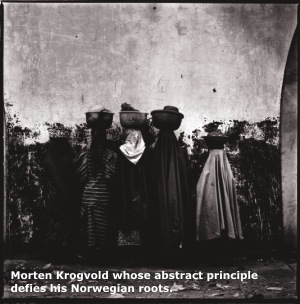 Working
with these children has its share of mental agony, as often
his subject died or became so ill that Prince himself had
go hunting for blood donors. About his effort Prince has one
thing to say, "Children in my photographs don't have
any other concern but pleasure. They're resisting a critical
future, which they can't change." Working
with these children has its share of mental agony, as often
his subject died or became so ill that Prince himself had
go hunting for blood donors. About his effort Prince has one
thing to say, "Children in my photographs don't have
any other concern but pleasure. They're resisting a critical
future, which they can't change."
Shahidul Alam, who holds the opinion that
image-makers had always been underrated on the home front,
will display his work where he captures the "till now
unveiled women members who joined the Naxal Movement. While
working on these "politically motivated women who had
once dreamt of bringing about a new social order" Alam
not only caught them in frame but also extracted the words
that put these portraitures in true context. He believes that
words and pictures have a deep-rooted relationship and that
together they become more effective in creating new interpretations.
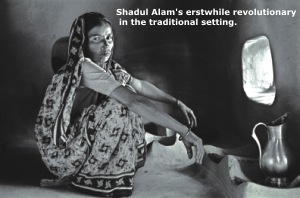 Recalling
his experience of photographing the Naxal women, Alam recalls
one woman, Lathika, who affected the course of his work. And
when Alam was to photograph her she became stiff with discomfort
and Alam remembers how she grumbled over her social status.
She said, "I once had a great desire to be photographed
but then it wasn't possible… at present I would have
to take my husband's permission…Is this the freedom
I gained by leaving my own household? Is this what we fought
for?" Recalling
his experience of photographing the Naxal women, Alam recalls
one woman, Lathika, who affected the course of his work. And
when Alam was to photograph her she became stiff with discomfort
and Alam remembers how she grumbled over her social status.
She said, "I once had a great desire to be photographed
but then it wasn't possible… at present I would have
to take my husband's permission…Is this the freedom
I gained by leaving my own household? Is this what we fought
for?"
Through
his unusual encounter Alam realised that to depict the saga
of the revolutionary women he must not abandon the stories
behind their faces, stories that the present generation of
Bangladeshis have no inkling of.
 Alongside
showcasing the three photographers from Bangladesh the Chhobi
Mela recognises the contribution of pioneers of Bangladesh.
It also highlights the efforts of the women photographers
in today's world. Alongside
showcasing the three photographers from Bangladesh the Chhobi
Mela recognises the contribution of pioneers of Bangladesh.
It also highlights the efforts of the women photographers
in today's world.
Momena
Jalil, a journalist who completed the course offered at Pathshala,
believes photographers groom themselves so that they can collect
another frame, a frame that will outlive them, and press forward
their beliefs and dreams. "It is like a natural yearning
for reproduction in order to continue living through the next
generation," Momena asserts. And Drik, with there Chobi
Mela in mind, has arranged for showcasing the works of those
photographers who have, in their own personalised way, successfully
worked along this line. Big guns like Reza Deghati, Sudharak
Olwe, Robart Pledge, Morten Krogvold, Raghu Rai, David H Wells,
and many more will show their work. From the younger generation,
rising stars like Shadi Ghadirian, Manit Sriwanichapoom, Trisha
Ziff, Chris Yap and more will enjoy exposure in Bangladesh
for the first time.
 Chobi
Mela is a platform that tightens the bond between countries,
believes Suvendu Chatterjee, the man at the helm of the Kolkata
branch of Drik. "As everyone knows Roghu Rai is adverse
to exhibitions, but it was Raghu himself who expressed the
desire to be a part of the festival. Isn't that an achievement
for Chobi Mela and Drik? This international festival has constructed
a bridge, particularly between Bangladesh and India,"
He adds. Chobi
Mela is a platform that tightens the bond between countries,
believes Suvendu Chatterjee, the man at the helm of the Kolkata
branch of Drik. "As everyone knows Roghu Rai is adverse
to exhibitions, but it was Raghu himself who expressed the
desire to be a part of the festival. Isn't that an achievement
for Chobi Mela and Drik? This international festival has constructed
a bridge, particularly between Bangladesh and India,"
He adds.
The
festival consists of 37 Exhibitions of which 10 are mobile.
Seven workshops are scheduled to be conducted by leading photographers
like Pedro Meyer, Morten Krogvold and Peter Fryer. Moreover
Barbara Stauss (Photo editor), Liz Wells, Dick Doughty and
Rupert Grey will also be conducting workshops during the festival.
Lectures, presentations and film sessions will mark this third
Chobi Mela at the Goethe Institut for six consecutive evenings.
Fine artists, documentary photographers, and photographers
who have produced conceptual work are participating individually
and in groups. Films, videos and multimedia presentations
that have a direct relevance to the theme of the festival
will also be shown in the regular evening screenings. Guest
artists who are unable to attend will participate through
video conference.
 All
this calls for a lot of well-co-ordinated steps. At the Drik
headquarters, Shalini, the co-ordinator of Chobi Mela III
and her coworkers are hopeful to pull off a memorable festival.
They have been putting their efforts together towards that
end for the last three months. Yet there are critics who believe
that Chobi Mela is not accommodating to the photographers
of the home front. No one recalls any important show by an
important Bangladeshi photographer which Drik ever organised.
Many reputed younger generation photographers also complain
of Driks being a strict adherent of documentary photography,
which puts a heavy premium on the works of photographers who
work outside this genre, as they are lagging behind in their
effort to draw appreciation. However Shahidul Alam is not
against photography as art. But he, with the help of his organisation
intends to carry out the mission of freezing the moments of
reality for posterity overlooking the worries of whether or
not the images fall in the category of art. All
this calls for a lot of well-co-ordinated steps. At the Drik
headquarters, Shalini, the co-ordinator of Chobi Mela III
and her coworkers are hopeful to pull off a memorable festival.
They have been putting their efforts together towards that
end for the last three months. Yet there are critics who believe
that Chobi Mela is not accommodating to the photographers
of the home front. No one recalls any important show by an
important Bangladeshi photographer which Drik ever organised.
Many reputed younger generation photographers also complain
of Driks being a strict adherent of documentary photography,
which puts a heavy premium on the works of photographers who
work outside this genre, as they are lagging behind in their
effort to draw appreciation. However Shahidul Alam is not
against photography as art. But he, with the help of his organisation
intends to carry out the mission of freezing the moments of
reality for posterity overlooking the worries of whether or
not the images fall in the category of art.
As
for the recent Chobi Mela, Alam says, "We felt this was
the time to 'resist' and many of the photographers have taken
on the theme to express their deep resentment to a world order
that is clearly unjust." Perhaps in times of war, art
should take the back seat.
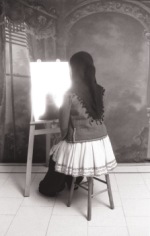 Shadi
Ghadirian is an Iranian photographer with a knack
for poking fun, that to in a very subtle way, at the censorious
atmosphere of her country. She pokes fun at her chosen subjects
in an intelligent way. Her images are constructed realities
that tend to deconstruct the reality that she is a part of.
As a critic who points a finger at the disparities inherent
in the social fabric, she does not remain aloof of her subject
matter. "By means of photography I can show the world
around me -- adoration, inspiration, and complaint. For the
time being the most appealing issue to me is women's lives
that I'm exposed to. They are images of my life," says
Ghadirian. This testimony is enough to sum up this social
critic. Ghadirian, a graduate in photography from Azad University
in Tehran, is not willing to sever her ties with her own society.
She is not an artist writhing in the agony of alienation;
being a part of the community she lives in and the persons
she meets, she simply cares for revealing the truth. Her models
are often her friends and acquaintances. As for her way with
her subjects, she simply brought them under a critical light
that never compromises her position as the admirer of the
image. Shadi
Ghadirian is an Iranian photographer with a knack
for poking fun, that to in a very subtle way, at the censorious
atmosphere of her country. She pokes fun at her chosen subjects
in an intelligent way. Her images are constructed realities
that tend to deconstruct the reality that she is a part of.
As a critic who points a finger at the disparities inherent
in the social fabric, she does not remain aloof of her subject
matter. "By means of photography I can show the world
around me -- adoration, inspiration, and complaint. For the
time being the most appealing issue to me is women's lives
that I'm exposed to. They are images of my life," says
Ghadirian. This testimony is enough to sum up this social
critic. Ghadirian, a graduate in photography from Azad University
in Tehran, is not willing to sever her ties with her own society.
She is not an artist writhing in the agony of alienation;
being a part of the community she lives in and the persons
she meets, she simply cares for revealing the truth. Her models
are often her friends and acquaintances. As for her way with
her subjects, she simply brought them under a critical light
that never compromises her position as the admirer of the
image.
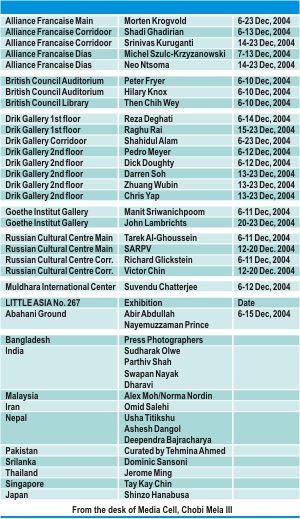
Copyright
(R) thedailystar.net 2004
|
| |
